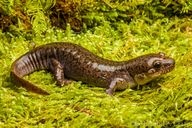|
Dicamptodon tenebrosus (Baird & Girard, 1852)
Pacific Giant Salamander, Coastal Giant Salamander | family: Dicamptodontidae genus: Dicamptodon |
 © 2013 John P. Clare (1 of 98) |
|
|
|
Description Distribution and Habitat Country distribution from AmphibiaWeb's database: Canada, United States U.S. state distribution from AmphibiaWeb's database: California, Oregon, Washington Canadian province distribution from AmphibiaWeb's database: British Columbia
Adults inhabit damp, dense forests (especially Coastal Redwood and Douglas Fir), usually in the vicinity of streams or seepages. Found under logs, rocks, bark, or other objects or sometimes crawling in the open. Occasionally climbs and has been recorded to a height of 8 ft. (Stebbins 1951). Larvae are found in small to medium sized creeks and streams in habitat similar to that in which adults are found. Life History, Abundance, Activity, and Special Behaviors Adults are very good diggers and likely burrow at the base of a spring upon arrival of the autumn rains. Indeed, adults have been found under ground at a depth of 20 ft. (Dethlefson 1948). Nests of 83 and 146 eggs, attended by females, have been found in rocky areas nears streams and seeps. One nest was under rocks 3 feet from the surface. Egg deposition is in the spring (early May) and hatching may occur up to 9 months later (Nussbaum 1969). Adults are very powerful and can inflict a painful bite when handled. They are also known to emit an audible growl or bark when threatened (Stebbins 1951 1985). Adults are relatively rare and are a good find even in prime habitat, especially considering the abundance of the larvae in streams of the Pacific Northwest. Larva Larvae are mainly found in small to medium sized mountain streams (Nussbaum and Clothier 1973) and are most common in areas where stones and cobbles cover the stream bottom with little silt (Murphy and Hall 1981). Censuses by Murphy et al. (1981) showed that D. tenebrosus larvae are the dominant vertebrate fauna in terms of biomass in the Cascade Mountain Streams that were sampled. Predators include fish, common garter snakes (Thamnophis sirtalis), northern water shrews (Sorex palustris), river otters (Lutra canadensis), weasels (Mustela) and other Dicamptodon (Nussbaum et al. 1983). Trends and Threats Relation to Humans Possible reasons for amphibian decline Habitat modification from deforestation, or logging related activities Comments This species is remarkable in their gregariousness, their formidable bite, their production of a “bark” (Stebbins 1951 1985), their large size, and consumption of mammals and other amphibians. More work is necessary to determine the impacts that logging has had and the impacts that future logging could have on the abundance of this species. See another account at californiaherps.com.
References
Childers J, Singh K, and Koo M. (2020). ''Natural History Note: Dicamptodon tenebrosus (Pacific Giant Salamander) Diet.'' Herpetological Review , 51(4), 806-807. Corn, P. S. and Bury, R. B. (1989). ''Logging in Western Oregon: responses of headwater habitats and stream amphibians.'' Forest Ecology and Management, 29, 39-57. Dethlefsen, E.S. (1948). ''A subterranean nest of the Pacific Giant Salamander, Dicamptodon ensatus (Eschscholtz).'' Wasmann Collector, 7, 81-84. Diller, J. S. (1907). ''A salamander-snake fight.'' Science, 26, 907-908. Good, D.A. (1989). "Hybridization and cryptic species in Dicamptodon (Caudata: Dicamptodontidae)." Evolution, 43, 728-744. Hawkins, C. P., Murphy, M. L., Anderson, N. H., and Wilzbach, M. A. (1983). ''Density of fish and salamanders in relation to riparian canopy and physical habitat in streams of the northwestern United States.'' Canadian Journal of Fisheries and Aquatic Sciences, 40, 1173-1185. Leonard, W.P., Brown, H.A., Jones, L.L.C., McAllister, K.R., and Storm, R.M. (1993). Amphibians of Washington and Oregon. Seattle Audubon, Seattle. Munro, W. T. (1993). ''Designation of endangered species, subspecies and populations by COSEWIC.'' Our Living Legacy: Proceedings of a Symposium on Biological Diversity. M. A. Fenger, E. H. Miller, J. F. Johnson, and E. J. R. Williams, eds., Royal British Columbia Museum, Victoria, B.C., Canada, 213-217. Murphy, M. L. and Hall, J. D. (1981). ''Varied effects of clear cut logging on predators and their habitat in small streams of the Cascade Mountains, Oregon.'' Canadian Journal of Fisheries and Aquatic Science, 38, 137-145. Murphy, M. L., Hawkins, C. P., and Anderson, N. H. (1981). ''Effects of canopy modification and accumulated sediment on stream communities.'' Transactions of the American Fisheries Society, 110, 469-478. Nussbaum, R. A. (1969). ''Nests and eggs of the Pacific Giant Salamander, Dicamptodon ensatus (Eschscholtz).'' Herpetologica, 25, 257-262. Nussbaum, R. A. (1976). "Geographic variation and systematics of salamanders of the genus Dicamptodon Strauch (Ambystomatidae)." Miscellaneous Publications of the Museum of Zoology, University of Michigan, 149, 1-94. Nussbaum, R. A., Brodie, E. D., Jr., and Storm, R. M. (1983). Amphibians and Reptiles of the Pacific Northwest. University of Idaho Press, Moscow, Idaho. Nussbaum, R. A., and Clothier, G. W. (1973). ''Population structure, growth, and size of larval Dicamptodon ensatus (Eschscholtz).'' Northwest Science, 47, 218-227. Orchard, S.A. (1992). ''Amphibian population declines in British Columbia.'' Declines in Canadian amphibian populations: designing a national monitoring strategy. C. A. Bishop nd K.E. Petit, eds., Canadian Wildlife Service, 10-13. Petranka, J. W. (1998). Salamanders of the United States and Canada. Smithsonian Institution Press, Washington D.C. and London. Stebbins, R. C. (1985). A Field Guide to Western Reptiles and Amphibians. Houghton Mifflin, Boston. Stebbins, R.C. (1951). Amphibians of Western North America. University of California Press, Berkeley. Originally submitted by: Kevin Marsee (first posted 1999-02-23) Edited by: M. J. Mahoney, Michelle S. Koo (2022-08-18) Species Account Citation: AmphibiaWeb 2022 Dicamptodon tenebrosus: Pacific Giant Salamander <https://amphibiaweb.org/species/3867> University of California, Berkeley, CA, USA. Accessed Jun 2, 2025.
Feedback or comments about this page.
Citation: AmphibiaWeb. 2025. <https://amphibiaweb.org> University of California, Berkeley, CA, USA. Accessed 2 Jun 2025. AmphibiaWeb's policy on data use. |




 Raffaëlli Account
Raffaëlli Account Map of Life
Map of Life